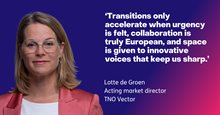Be consistent and ensure financial security in the long term
In 2022 the R&D intensity amounted to 3.4% in Belgium, 3.1% in Germany, 2.9% in Denmark and 2.3% in the Netherlands. These numbers are shown in a previous comparative study by TNO, which was performed in cooperation with the board of Innovation and Knowledge from the Ministry of Economic Affairs.
Germany, Denmark and Belgium are pursuing an innovation policy in this respect and offer a level of security when it comes to funding innovations in the long term.
Jasper: “R&D investments are and will be long-term investments. When you set up a laboratory somewhere, you cannot just move it to another country. So, consistency is key. You can see that in all three countries.”
In Denmark, for example. Carine: “When the 3% EU-target was announced, Denmark took this quite seriously and rearranged their policy. As part of this, the Danish government budgets 1% of the GDP for structural R&D investments every year.”
Belgium makes R&D attractive in a financial way by using fiscal measures, which have not been significantly changed since 2006. Germany offers a wide range of consistency by means of long-term arrangements and multi-annual pacts between federal government and states.
Identify opportunities and make targeted investments
The private industry plays an important part in the R&D system of Germany, Denmark and Belgium. R&D specifically grew in matured industries. These industries are getting government support to become or remain internationally competitive.
In that way, Belgium actively invests in the pharmaceutical industry and keeps monitoring possible opportunities. Jasper: “They have raised a separate observatory for the pharmaceutical industry, which advises the government. Their sole purpose is to observe whether Belgium is still internationally competitive for pharma companies.
Denmark and Germany too are making choices in their R&D policy. Denmark, for example, focuses on wind power and the pharmaceutical industry, whereas Germany opted for investments in the automotive industry, an existing and high-tech sector. For instance, by supporting the transition of petrol-driven cars into electric ones.”
Ensure better cooperation between government, businesses and public research institutes
The private sector takes a great share of the R&D expenditures. An attractive environment for both establishment and investments contribute to private investments in R&D.
But public institutes are also important to the overall volume of R&D expenditure. In this way, Belgium, Germany and Denmark prove cooperation between government, businesses and public institutes to be effective. An integral approach within this so-called innovation-eco system leads to better targeted and more effective innovation policies and stimulates technological progress.
For example, when investing, Germany does not only focus on the automotive industry but also on extra-university organisations and educational institutions. Belgium and Denmark are also actively encouraging the cooperation and learning exchanges between industry, education and research.
Jasper: “Stimulating innovation throughout the region is important to the entire eco-system. It is not just one company or organisation, you need to have a wider view. When one company makes a new invention, another can pick it up and build on that. And actors in the innovation and ecosystem will develop human capital within the region. Those people may eventually switch from university A to company B and C.”
Lastly: R&D is an investment for the future
R&D investments do not lead to instant results. But, as shown by the developments in Germany, Belgium and Denmark, R&D investments are an investment to the future. It ensures our continuity in international competition.
Carine: “R&D is a key element for our economy. It increases productivity and earning power and it is a means to attract more innovations to a country. Many parties may benefit from that.”
It is also essential in our approach to our societal challenges. Jasper: “Think of the energy transition, climate change and ageing. The only way to tackle those challenges, and simultaneously ensure we do not fall back, is by means of technology and innovation.”






